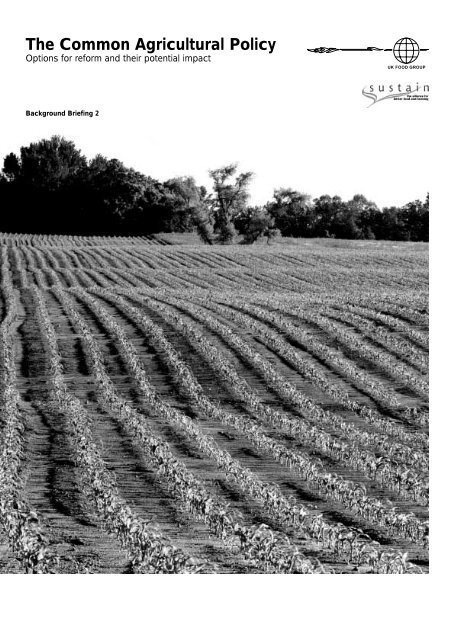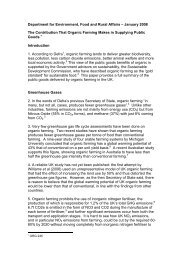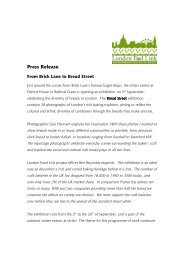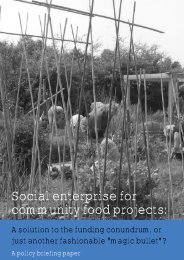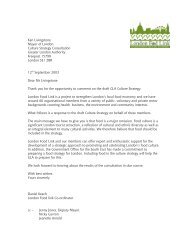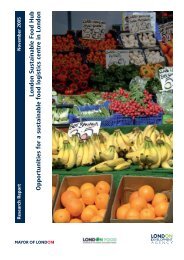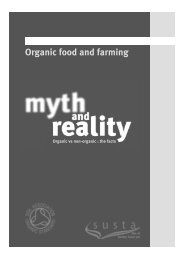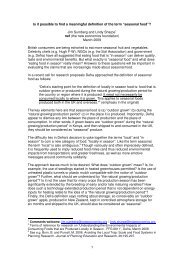Common Agricultural Policy - UK Food Group
Common Agricultural Policy - UK Food Group
Common Agricultural Policy - UK Food Group
- No tags were found...
Create successful ePaper yourself
Turn your PDF publications into a flip-book with our unique Google optimized e-Paper software.
The <strong>Common</strong> <strong>Agricultural</strong> <strong>Policy</strong>Options for reform and their potential impact<strong>UK</strong> FOOD GROUPBackground Briefing 2
The <strong>Common</strong> <strong>Agricultural</strong> <strong>Policy</strong>IntroductionThe <strong>UK</strong> <strong>Food</strong> <strong>Group</strong> and Sustain are calling for a moresustainable and equitable agricultural policy for theEuropean Union. In support of this work, the <strong>UK</strong> <strong>Food</strong><strong>Group</strong> and Sustain commissioned the Institute forEuropean Environmental <strong>Policy</strong> (IEEP) to produce a briefingpaper outlining the main reform scenarios for the <strong>Common</strong><strong>Agricultural</strong> <strong>Policy</strong> (CAP) and their impacts on keystakeholders: consumers, small farmers, developingcountries and the environment.Other briefings in the CAP series include, BackgroundBriefing 1: The <strong>Common</strong> <strong>Agricultural</strong> <strong>Policy</strong>: How the CAPoperates, the key commodities, competitors and marketsfor the European Union. (<strong>UK</strong> <strong>Food</strong> <strong>Group</strong>/Sustain 2002)<strong>UK</strong> <strong>Food</strong> <strong>Group</strong>The <strong>UK</strong> <strong>Food</strong> <strong>Group</strong> is a network of non-governmentalorganisations from a broad range of development, farming,consumer and environment organisations, who share acommon concern for global food security. Through raisingawareness of the impact of globalisation in food andagriculture the <strong>UK</strong> <strong>Food</strong> <strong>Group</strong> seeks to promotesustainable and equitable food security policies. Thepriority areas of action are trade policies, sustainableagriculture and the regulation of food and agriculturetransnational corporations.Contact:Jagdish Patel, Coordinator,<strong>UK</strong> <strong>Food</strong> <strong>Group</strong>, PO Box 100,London SE1 7RT, <strong>UK</strong>Tel: 44 (0) 20 7523 2369Fax: 44 (0) 20 7620 0719Email: ukfg@ukfg.org.ukWeb: www.ukfg.org.ukSustain: The alliance for better food and farmingSustain represents over 100 national public interestorganisations working at international, national, regionaland local level. Sustain's aim is to advocate food andagriculture policies and practices that enhance the healthand welfare of people and animals, improve the workingand living environment, promote equity and enrich societyand culture.Contact:Vicki Hird, <strong>Policy</strong> Director,Sustain: the alliance for better food and farming,94 White Lion Street,London N1 9PF,Tel: 44 (0) 20 7837 1228Fax: 44 (0) 20 7837 1141Email: vh@sustainweb.orgWeb: www.sustainweb.orgResearch: The Institute for European Environmental <strong>Policy</strong>This background briefing has been funded by ActionAid,Christian Aid, CAFOD, Methodist Relief and DevelopmentFund, Oxfam (GB), the Rowan Trust, RSPB, Save theChildren Fund (<strong>UK</strong>), RSPCA and the European Commissionunder its programme to raise public awareness ofdevelopment issues.July 2002
ContentsIntroduction 2The background to CAP reform 3Proposals for reform 4The modified status quo 4The Cork model 5Radical liberalisation 8Potential impacts of reform 9On consumers 9On small farms 11On Developing Countries 12On the environment 15Conclusions 17References and Bibliography 19
The <strong>Common</strong> <strong>Agricultural</strong> <strong>Policy</strong>2IntroductionAn important feature of the variety of reform proposals thathas been made, is in the level of detail that they include. Ingeneral, those organisations and interests that havetraditionally taken less of an active role in campaigning forCAP reform tend to call for a fairly crude set of changes –eg reduced prices to consumers, less protection forproducers – without specifying how these changes shouldbe achieved through the modification of policy instruments.By contrast, those who have become more embroiled inthe policy development process may make highly detailedsets of recommendations for future policy (eg demands for25% of the future budget to be spent on agri-environmentmeasures, calls for suckler cow premia to be increased,proposals to switch livestock headage payments to areapayments). Overall, most groups have not articulated a fullydeveloped ‘alternative policy package’, although someNGOs such as Birdlife and the European EnvironmentalBureau (EEB) are attempting to do so.For these reasons, this paper does not include anexhaustive documentation or analysis of all proposals forCAP reform and their likely impacts on small farmers,developing countries, consumers or the environment. To doso would require us to make many assumptions about thedesired details of the various reform proposals, in order todiscuss their impacts in each case.Instead, we have opted to group the main types of reformproposal into broad ‘archetypes’ or models that representthe most clearly-defined short or longer term options forthe future, and to undertake our impact analysis in relationto these. In so doing, we will lose some of the interestingpotential effects of certain more detailed proposals (eg inrelation to specific individual policy instruments within thebroad CAP package), but we will be able to undertake theimpact analyses with a much greater degree of clarity.
The <strong>Common</strong> <strong>Agricultural</strong> <strong>Policy</strong> 3The background to CAP reformIn recent years, the volume and variety of proposals forfurther reform of the CAP have increased. They have comefrom Member State governments, from the EuropeanCommission (EC), from farmers’ organisations and from anincreasing number of NGOs, particularly those working onenvironmental and consumer issues.In the main, recent proposals for further CAP reform arisefrom concerns about the following issues and developments.• The budgetary and market impacts of the plannedenlargement of the EU to embrace central and easternEuropean countries (CECs), as these countries havepotentially highly productive agricultural sectors whichhave a far lower level of support than that in the existingEU. Put simply, some existing Member States (egGermany, the <strong>UK</strong>) are not prepared to consider supportingthe agriculture of countries such as Poland to the sameextent that their own domestic agriculture is supported, asthis would entail greatly increased EU spending onagriculture and much larger Member State contributionsto the EU budget. However, the principle of the singleEuropean market means that it would be difficult tosustain unequal treatment for farmers in CECs comparedto those in the existing Member States, for any significantlength of time following accession, so it is argued thatthe CAP itself will have to change, to enable accession.• The environmental impacts of the current policy, which iswidely seen as a hindrance to the promotion andexpansion of less intensive and more sustainable farmingsystems across the EU and which has undoubtedly had arole in encouraging unsustainable resource use inagriculture, in recent decades (<strong>UK</strong>FG/Sustain, 2002).• The forthcoming round of World Trade Organisation(WTO) negotiations and the intention to negotiate a newagreement on agriculture which should take further stepstowards liberalisation in agricultural trade. Although theEU’s starting point for these discussions is that it hasalready made significant moves to liberalise its marketsthrough the Agenda 2000 reforms, many commentatorspredict a need for European policy to accept furtherreforms as part of the negotiation of a new settlement.This pressure is intensifying with the expiry of the ‘peaceclause’ on the substantial blue box element of the CAP atthe end of 2002, and the aggressive stance being taken bythe Cairns group and other exporters, in the run-up to thenew round.• The failure of the CAP to protect ‘small family farms’ fromcontinuing economic pressures to enlarge, specialise andindustrialise, with consequent rapid decline in the farmpopulation in both productive and marginal areas.• <strong>Food</strong> scares and reduced consumer confidence inagricultural products and production methods, especiallyin north west Europe.In addition, some groups and sectors have long called formore radical and fundamental reform of the CAP on morebasic grounds related to liberal economic theory and thealleged costs of ‘protection’ as opposed to free markets,including the supposed costs of the policy to consumers.These groups include some consumer organisations, manyagricultural economists worldwide, and key internationalorganisations such as the Organisation for EconomicCooperation and Development (OECD), as well as theCairns group of agricultural exporting nations which areactive within the WTO.So, the underlying impetus for reform comes from severalquite different critiques of the CAP, whose motives do notnecessarily dovetail in any particularly clear way. For some,the key consideration is to ensure that the policy does notcost domestic taxpayers too much money while stillproviding support to the farming sector. For others, it is toremove any incentives to farm in ways which damage theenvironment and to provide more incentives to produce ormaintain environmental goods and services. For a thirdgroup, it is to encourage a more explicitly ‘small is beautiful’sustainable agriculture sector, with smaller family farmsproducing high quality goods for mainly local markets andcontinuing to employ a significant number of people andmake a significant contribution to rural communities. Onestrand in the environmental and sustainability campexplicitly supports organic farming as a central feature inachieving these aims. For a fourth group of reformists, thegoal is to demonstrate further moves towards the removalof the most ‘trade distorting’ elements of the policy –notably, export subsidies and import taxes. Finally, forthose who oppose the CAP on free market grounds, thekey aim is to reduce protection overall – that is, includingany domestic support which effectively subsidises producers’costs, as well as import tariffs and export subsidies.
The <strong>Common</strong> <strong>Agricultural</strong> <strong>Policy</strong> 4Proposals for reformThree models of reform1: ‘the modified status quo’= A further decoupling of first pillar aids and marketsupport regimes and significant reduction of exportsubsidies and import tariffs, but no significant shift ofresources out of first pillar measures.2: ‘The Cork model’= A significant shift of existing CAP resources fromfirst to second pillar through modulation, degressivityor more ambitious systems such as ‘bonds’ appliedto first pillar aids and market support regimes, andsignificant enlargement of spending on ruraldevelopment and environment.3: ‘radical liberalisation’= A significant net reduction in support to theagricultural sector involving a major reduction indirect aids and in market support but without anexplicit, corresponding increase in aid for otherpurposes (eg environment and rural development)and the use of much less interventionist policymechanisms for the sector as a whole.Model 1: ‘the modified status quo’This model concentrates the process of reform on meetingWTO goals to reduce ‘amber box’ forms of protectionistpolicy which still apply to many CAP sectors, therebyenabling the EU to respond to pressures to cut exportsubsidies and import tariffs.It would involve reform of the dairy, sugar and olive oilregimes to cut guaranteed prices to these producers andwould enable the removal of production quotas in dairy andsugar as a consequence. In those regimes which havealready become ‘partially decoupled’ – ie arable crops andbeef and veal – it would continue this process by reducingguaranteed prices to world market levels. However, thesereforms would not require the removal of direct paymentsto producers, and it is likely that in those regimes wheredirect payments do not already exist (eg dairy and sugar),they would need to be introduced as ‘compensation’ inreturn for cuts in guaranteed prices. In the longer term, inview of enlargement, it is unclear what would happen todirect payments but it is theoretically possible that theenlargement countries could successfully demand suchpayments for their own producers.As the Agenda 2000 reforms introduced a new ability forthe application of environmental cross-compliance to alldirect payments under the CAP, this model would providescope for a form of ‘greening’ of the policy in thatenvironmental conditions could be applied to an increasingarray of the direct payments on offer to different producers.In view of wider developments in EU policy it seems likelythat cross-compliance would be more widely used than ithas been to date, under this scenario.Key outcomes•The EU could greatly reduce its use of export subsidiesand import tariffs for the major sectors;• EU producers would still receive support for producingfood but the level of that support would be less directlydependent on current output. However, it would probablybe based largely on the area of land farmed, potentiallywith some ‘ceilings’ on support for the largest producers.(This is more likely to happen in some Member Statesthan others, eg by using modulation of direct aids, asallowed for in the Agenda 2000 reforms – see<strong>UK</strong>FG/Sustain 2002.)• The cost of the CAP to taxpayers would increasesignificantly, while, in principle, the cost to consumers(processors and retailers) would fall;• The main mechanism for pursuing environmental goalsvia the CAP would be through cross-complianceconditions attached to direct payments and through theexisting requirement that these payments should notundermine or contradict ‘environmental protectionrequirements’ (eg the requirements of EU environmentallegislation);• There is unlikely to be a significant increase in resourcesdevoted to second pillar measures (targeted funds forrural development, farming in marginal areas, agrienvironment)since the first pillar would remain so costly;• There would probably be a continued decline in smallfarms through competitive pressure within the singleEuropean market and increasingly with world marketcompetitors, as tariffs reduce;
The <strong>Common</strong> <strong>Agricultural</strong> <strong>Policy</strong>5•‘Export dumping’ using export subsidies would cease,but since EU producers would still be supported by directaids, they would continue to have a competitiveadvantage on world markets.Proponents of this model• Member States who are basically supportive of the CAPand anxious to protect their own farm sectors in arelatively established way (potentially France, Benelux,Spain) have some sympathy with this approach althoughit would nevertheless represent a much more radicalchange than some would prefer (see Conclusion).• Some major farmers’ organisations (eg COPA ),although they remain unhappy about the use ofcross-compliance on direct payments;• Some interests within the European Commission forwhom it offers a potentially simple response to WTOissues and a potential simplification of CAP policyinstruments, as direct payments are graduallyharmonised between regimes (eg adopting a standarddirect payment for all arable crops, over time, and thentransforming livestock headage payments into areapayments, to increase decoupling and simplifyadministration, leading to a unified area payment onall land);• Some consumer interests, since it would meet theirimmediate concerns about removing price supports andquotas and food prices should fall, in general;• A minority of environmental interests who areunconvinced as to the value of second pillar aids andwhose primary concern is to increase the use ofenvironmental cross-compliance to constrain negativeCAP impacts upon the environment.Model 2: ‘The Cork model’This is the model essentially underlying the visionexpressed in the 1997 ‘Cork Declaration’ on future ruralpolicy in Europe. It involves the gradual transformation ofthe CAP from a policy focused upon support to theagriculture sector for production and market reasons, to apolicy focused upon support to rural areas (predominantlyto farm businesses, emphasising farming’s role in this), andgiven for explicit social, rural development andenvironmental goals. This would entail the reduction of allsupport given to farmers under the existing production‘regimes’ (full decoupling) and its replacement by a raft ofpolicies for environmental management, marginalproducers, and the stimulation of rural economies throughtraining, investment and diversification aids. However, avariety of mechanisms has been proposed for achievingthis shift in resources from first to second pillars.Under compulsory modulation, which would be adevelopment of the current voluntary provisions, MemberStates would be required to make cuts in direct aids toproducers and to use the savings generated in their ruraldevelopment programmes under the second pillar. UnderAgenda 2000, modulation was introduced as an option forMember States to use if they so desired, and the <strong>UK</strong>,France, Portugal, Germany and the Netherlands have alltaken up this option or are proposing to do so by 2003.Currently, modulation money can only be used for agrienvironment,marginal farming, farmland afforestation andearly retirement aids under the second pillar, but thisrestriction could be lifted.Importantly, modulation can be applied in a progressive ora neutral way. Member States can use it selectively to cutaids to the wealthiest or largest producers and exemptsmaller producers from the cuts, or they can choose toapply it equally to all farms as a standard proportion of theaids they receive. Different interest groups place verydifferent emphasis upon their preferences for usingmodulation in one or other of these ways. With progressivemodulation, it would in theory be possible to attempt toredress some of the current distributive effects of CAPpayments which favour larger producers, by cutting theiraids much more significantly and protecting aid to smallerfarms. However, some critics of this tactic argue that ifapplied to any significant degree it would simply encourage‘paper splitting’ of farm businesses rather than applying abrake on pressures to enlarge and shed labour. As the <strong>UK</strong>has implemented modulation in a ‘standard’ way whileFrance is applying it ‘progressively’, lessons from these earlyimplementers are likely to be valuable for the longer term.Under degressivity, progressive cuts in direct aid toproducers would be made centrally by the EU, in stages overtime, and funds reallocated centrally to the second pillarbudget. It is potentially possible for these cuts to be made ina progressive or a neutral way – as with modulation – but itseems administratively unlikely that a progressive methodwould be adopted and simple, across-the-board percentagecuts in direct payments applying to each regime aremore likely.
The <strong>Common</strong> <strong>Agricultural</strong> <strong>Policy</strong>6Under bonds, the basic method for removing first pillar aidwould be to offer farmers a one-off compensation paymentrather than direct aids over a continuing period, in return forcuts in guaranteed prices for different commodities. Certaininfluential agricultural economists (eg Tangermann (D),Harvey (<strong>UK</strong>)) favour this option over direct paymentsbecause it gives a ‘once for all’ measure and thus avoidsgovernments getting locked in to continuing compensationwhich itself becomes a form of producer subsidy.Of these mechanisms, modulation or degressivity arealready potentially applicable to those regimes whichalready offer direct payments to producers (eg arable, beef,sheep) but in order to apply them to market-supportedregimes (eg dairy, sugar) you would first need to undertakefurther decoupling, as described under Model 1. Bondsoffer the advantage to these regimes that they could beintroduced as an alternative to direct payments, but inrespect of the arable, beef and sheep sectors the directpayments would have to be ended, if bonds were introduced.(nb as adjustment mechanisms, both degressivity andbonds provide means to cut the size of the first pillar ofthe CAP, but do not necessarily require the savings to beused to fund the second pillar. In the case of the 'Corkmodel' of reform, it is assumed that they would be appliedwith an explicit commitment to increase resourcessimultaneously for the second pillar, on a similar scale tocurrent first pillar spending).Key outcomes• The existing CAP budget would be largely sustained;• Very little of this would be spent on classic forms ofmarket support and there would be a reduced internalmarket need for export subsidies or import tariffs,assuming that EU prices fell to nearer world marketprices (as has been seen with wheat);• Rural businesses (mainly farms) would receive relativelysignificant sums of money to manage the environment, tokeep farming in marginal areas, and to develop anddiversify their enterprise mix and sector coverage, as wellas assistance with skills development, provision ofinfrastructure and marketing and processing investment;• This could effectively give a sufficient level of incomesupport to allow agricultural production to be highervolume or lower cost than without the policy, but theeffects are likely to be weak, non-uniform and much lesstrade distorting than the support regimes that they replace;• Second pillar aids will target farm businesses in quite adifferent way to first pillar aids, so there are likely to belarge ‘gainers’ and ‘losers’ from the policy shift, bycomparison with the current pattern of support;• There would probably be a reduced level of EUproduction of many significant commodities, particularlythose which are currently most heavily supported (egdairy, oilseeds, wheat, beef, sugar and wine, as well asminor crops like cotton and rice unless these becameexplicit targets for agri-environment schemes). Thiswould lead to reduced up- and downstream employmentin the sectors closest to production. However, agrienvironmentand rural development schemes maygenerate new alternative rural employment and in thefood processing sector, there could be increasedemployment opportunities particularly in large agroindustrieswho may be able to source their raw materialsmore cheaply.Proponents of this model• Most of the environmental NGOs active in the debate inEurope (eg Birdlife, EEB), among whom there is a generalview that rural areas need more resources available forenvironmental management and the protection ofmarginal areas while at the same time removingincentives to intensify agricultural production. It is arguedthat by decoupling funds from production and‘recoupling’ them to the explicit provision ofenvironmental and social goods and services, publicmoney would be more effectively used to produce ‘publicgoods’ and the market could be otherwise left todetermine patterns and intensities of production, subjectto environmental and other regulation;• Some farming and landowning interests, for whom thisscenario represents the most durable long-term way ofensuring that rural areas remain a significant target forfuture EU funding and support, on the basis of a new‘contract with society’ in which they generate the goodsand services that the public requires but which are notreflected in conventional markets for food and otherproducts. The European Landowners Organisation andcertain smaller farmers’ organisations have tended totake this position. (ELO, 2001);• Several of the ‘reformist’ Member States’ governmentsbroadly subscribe to this view of the desirable futuredirection of EU policy – notably the <strong>UK</strong>, Sweden,Denmark and Italy. The former French socialistgovernment and the German social democrats have alsoexpressed some support for this view, but there remain
The <strong>Common</strong> <strong>Agricultural</strong> <strong>Policy</strong> 7strong opponents of their positions within their owncountries who may be more or less influential in the longerterm. However, with all governments in this group, there isa variety of assumptions implied about the scale of the shiftof resources needed from first to second pillar. Amongsome governments (most notably the <strong>UK</strong>) there is a clearassumption that more money would be cut from the firstpillar than would be diverted into the second pillar –producing a significant net saving on CAP spend overall.In contrast, for other governments (notably France) theimplicit assumption is that second pillar spend would fullyreplace first pillar spend, retaining a substantial CAPbudget devoted to rural areas. The German government isparticularly schizophrenic on this point – its treasury wishesto reduce CAP spend, but its strong farming lobbies andrural ministers tend to imply that support for rural areas inGermany must be maintained.
The <strong>Common</strong> <strong>Agricultural</strong> <strong>Policy</strong> 8Model 3: ‘radical liberalisation’This archetype is the classic preserve of the mainstreammarket liberalisers, both in academia and among theexport-oriented governments of the Cairns group. It seesthe reduction of production support as the primary goal ofCAP reform, in order to allow markets to determine a ‘moreefficient allocation’ of resources and to set prices foragricultural goods and services. As such, the proposalsinvolve cutting all guaranteed prices to world market levelsand removing export subsidies, import tariffs and quotas onproduction, as well as removing all direct aid to producersthat is even partially linked to production and can thus besaid to be ‘trade distorting’ (full decoupling).In relation to the WTO categories of aid, it would entailremoval of all amber box support, removal of all blue boxsupport and potentially, curtailment of some kinds of greenbox support if these involved substantial and clear effectsupon producer costs. As with the 'Cork model' , this modelwould have to be applied using one or more of a variety ofmechanisms to decouple or remove first pillar supports,which could include degressivity and/or bonds. However,under this option, there would be no related, explicitcommitment to ‘grow’ the second pillar, and indeed anyaids under the second pillar would have to be justified andfunded independently and in ways which could bedemonstrated to cause minimal ‘trade distortion’.Proponents of this model would be likely to seek to avoidthe kinds of agri-environment payment that, for example,supported extensive pasture management by grazing withlivestock across large areas of the EU, on the grounds thatthis effectively subsidises livestock producers in Europewho are then able to sell at reduced prices by comparisonwith their international competitors. However, they would beless likely to criticise environmental policies which involvedpaying targeted groups of producers for specific benefitssuch as managing wetland areas for particular, threatenedspecies of bird or plant.Key outcomes• Export subsidies and import tariffs would cease, and EUprices would settle at or near world market prices. Thisimplies some greater price instability in the EU than atpresent, although world prices might become more stabledue to the greater scale of EU influence upon them;• In marginal areas of Europe, land prices would fall anddepopulation might accelerate;• Cost-cutting would be an imperative for survival,particularly in export-oriented sectors (eg dairy);• As production support is dismantled, there is likely to be amajor phase of structural adjustment on EU farmsincluding enlargement and the shedding of labourparticularly in those regions where current farm sizes aresmall and relatively ‘inefficient’ in classic economic terms.Proponents of this model• The majority of <strong>UK</strong> agricultural economists and some oftheir colleagues in other EU Member States;• The governments of the Cairns group of exporting nations(Australia, New Zealand, Canada, Brazil). While in the runupto the next WTO round most of these parties arefocusing their attention on eliminating amber and blue boxsupports, it is generally accepted that if the EU were toshift very large sums of money into green box secondpillar aids, these would also be a target for continuingcriticism as ‘disguised production support’ (as is the casefor the USA, currently);• Some leading figures in the <strong>UK</strong> food industry (eg LordHaskins) believe that agriculture should no longer besupported to a far greater extent than other industries,and this generally translates into a call to dismantle theCAP. However, in general, the interests of the foodindustry are in the removal of price supports, tariffs andproduction quotas, and they tend to be relatively silent orbroadly supportive in relation to the ‘second pillar’. Henceit may be unfair to assume that they would generallyfavour this model over the alternatives presented above;• Some consumer organisations and some organisationswho seek to represent developing countries, althoughmany are unclear about how the CAP should be reformedin order to promote development considerations and thusthe above comments in relation to the food sector mayalso be relevant here;• A minority of environmental NGOs remain unconvinced asto the merits of the second pillar measures of the CAPand thus would subscribe to the tactic of calling for theremoval of the CAP as the first priority, on the basis thatthis would do more environmental good than harm.Beyond this they would probably recognise the need formanagement resources for environmental purposes butmay feel that this could more effectively be done withoutthe mechanisms and politics of the CAP.
The <strong>Common</strong> <strong>Agricultural</strong> <strong>Policy</strong> 9Potential impacts of reformThe three main reform models all involve reforming thecurrent mix of policies so that the EU can largely phase outthe use of export subsidies and import tariffs – the mostvisible ‘trade distorting’ elements. This reflects the fact thatthe EU is already committed to reducing these kinds ofsupport and the Commission’s trade negotiators are talkingabout further reductions as part of the next agricultureround in WTO.Where they vary, is in how they choose to supportagriculture in the EU. In Model 1, the 'modified status quo',the majority of support remains tied to production sectorsand thus linked to production patterns, implying a stillevident trade distorting impact. In Model 2, support isgiven to environmental managers and marginal farmers, aswell as those who develop their businesses and benefit thewider rural economy. It will affect production choices andrelative costs but in a much less uniformly trade-distortingway – some aids could even be seen as a brake onproduction. In Model 3, the overall level of producersupport is envisaged to be significantly lower, so tradedistorting effects should be minimal but structural effectson the agriculture sector in the EU would be considerable.The likely impacts of these three models on consumers,small farms, developing countries, and the environment arediscussed below.Impacts on consumersUnder all three models, reforms would include the reductionof EU guaranteed prices to world levels, across most of theEU regimes where these currently apply. Thus marketprices within the EU for key commodities/raw materialswould fall, particularly for milk and milk products, sugar,cereals and oilseeds, beef and veal, olives and wine. Worldmarket prices might rise slightly because of the eliminationof export subsidies on these products. However it isimportant to remember the following factors:• A variety of economic estimates suggest that food pricescould fall by a significant amount if EU prices were nolonger artificially supported by the CAP. However most ofthese studies assume that the full extent of any pricecuts would be directly reflected in food prices in the shops.
The <strong>Common</strong> <strong>Agricultural</strong> <strong>Policy</strong> 10• Most ‘consumers’ of the raw materials produced byfarming in Europe are not individual families andhouseholds, but food distribution, processing andmanufacturing companies. Thus while theseorganisations would benefit immediately from lowerprices for their raw materials, there is no automaticguarantee that the price cuts would be passed throughto consumers, particularly in those commodities subjectto the longest processing and manufacturing chains.These would include dairy products and sugar, of whicha significant proportion undergoes secondary or tertiaryprocessing (eg milk – butter – ingredient in confectionery,biscuits, ready meals, etc).• In relative terms, household expenditure on food as aproportion of total spending has decreased significantlyover recent decades, and food today takes less than20% of average household incomes. In addition, agrowing proportion of food is now eaten out, rather thanprepared at home, and consumers eat a much higherproportion of processed and manufactured foods thanthey used to. Thus a higher proportion of their spendingon food goes on the costs of processing and retailing(including restaurant service, etc) than used to be thecase, reducing the scope for agricultural price cuts toaffect consumers’ everyday budgets.Farmers' organisations claim there would be a fall in thequality of food available to consumers without EU barriers,since production standards outside the EU are alleged tobe lower than those within it. This is a contentious pointrequiring judgement about production conditions, the use ofinputs, health and environmental legislation, enforcement ofstandards and other factors in a range of countries.There is some evidence of lower standards, includinghigher levels of pesticide residues in certain imported fruitand vegetables. However, in a recent study for DGAgriculture covering the US, Canada, Australia and NewZealand, it was found that the evidence for many suchclaims is relatively thin. One exception was farm animalwelfare where it appears that the EU’s productionstandards are generally higher than these exportingnations. There are other cases where EU standards arehigher than in the US, particularly in the livestock sector.Examples include the regulation of GMOs, the use ofantibiotics and hormone treated meat. In principle EUstandards might still be maintained through Communitylegislation, in such a way as to prevent market access tothese products inside the EU on human health grounds.
The <strong>Common</strong> <strong>Agricultural</strong> <strong>Policy</strong> 11Under Model 1, EU production would remain high becausesupport would still be related to the area of land or numberof livestock used in farming. Thus distribution, processingand manufacturing patterns are likely to remain similar tothe present, and consumption patterns may not altergreatly. At the same time, EU consumers would be payingthrough their taxes to support the costs of the policy. Ifcompensation payments had been introduced in all themain sectors where minimum guaranteed prices formerlyapplied, the total costs of the policy could be significantlygreater than at present, particularly if enlargement led tothe eventual extension of these payments to producers inthe applicant countries.Under Model 2, EU production might fall in some areas(especially in oilseeds, cereals, beef, sugar) and importswould make up a larger share of domestic processors’supplies. Funding should enable the environmental andsocial services provided by rural areas to be maintainedand the policies might provide additional support forregional products, organic food, branding and quality, thuspotentially increasing some areas of EU consumer choice.Under Model 3, the significant decline in funding for ruralareas could lead to changes in the types and levels ofservices that they provide to consumers as well as tosignificant declines in EU production of variouscommodities. This implies a greater proportion of EUconsumption being sourced from other countries; but forthe main commodities affected it is quite likely that themajor beneficiaries of these new market opportunitieswould be the USA and Cairns group of exporters.Impacts on small farmsThroughout Europe there is a trend towards a lower farmpopulation and increasing average farm size, accompaniedby a sizeable part time farming sector in many countries.Similar trends are evident elsewhere, particularly in themore liberalised economies such as the USA. This trendwill be difficult to reverse, despite mixed evidence aboutthe economic efficiency of very large farms (see RICS 1998).In the EU, farm size is usually measured either in relationto labour input or turnover or land area. In practice, farmswith a relatively large area of land at their disposal may bein a small category under the other two measurements.The bias within the CAP up to now has been towardsthose with the greatest level of production rather thanthose with the greatest land area. This could change ifarea payments become a more widespread tool,particularly in the livestock sector.Under Model 1, because blue box payments would still belinked to production patterns, larger farms would still tendto receive larger subsidies than smaller ones. However thesupport system would be familiar to small farmers,relatively easy-access and non-competitive, so it couldoffer some attractions by comparison with Model 2.Increased use of cross-compliance could offer somerelative benefit to extensive producers compared tointensive ones.Under Model 2, in theory, these payments should benefitsmall farms who manage more extensive or environmentallysensitive holdings, as well as those in marginal areas.However, environmental payments tend to be area basedso pay more to larger farms, and where they involve acompetitive application process or detailed monitoring andrecord-keeping, they may fail to attract small farms forwhom management time is often more stretched than onlarger farms. If progressive forms of modulation areadopted it is possible to discriminate in favour of smallerfarms, for example by exempting the smaller holdings fromcuts in support payments. Finally, because second pillaraids are delivered through nationally or regionallydetermined programmes, there is much scope to tailor aidsto suit local needs. Thus the extent to which the policy thenfavours small farms becomes a decision for national orregional administrations.Under Model 3, it seems likely that a significant number ofsmall farms in the EU would go out of business as thosethat survive have to pursue an even stronger drive for lowcost production, looking for economies of scale andsystem. However, evidence from previous economic downturnsis that there can be cost-cutting/value addingstrategies that involve staying small and diverse to surviveas well as those which involve enlargement andspecialisation. A lot depends upon local marketopportunities and support to develop new ideas andenterprises, as well as changes in the farm population andthe availability of complementary off-farm income. Inparticular, it seems likely that the trend towards anincreasing number of part-time or ‘hobby’ farms in manyregions of the EU could accelerate.Considering effects upon small farmers outside the EU, itseems likely that Model 1 would produce little change inthe existing picture, while Models 2 and 3 might increaseexporters’ incentives to produce for the EU market, whichcan give an incentive to restructure and favour largerproducers (RSPB, 2001).
The <strong>Common</strong> <strong>Agricultural</strong> <strong>Policy</strong> 12Impacts on Developing CountriesIn all models, the ending of export subsidies and importtariffs should increase opportunities for exporting countrieswho produce temperate agricultural products to access EUand other markets. Importing countries will be able tomaintain their own domestic production of certain productsbecause they will no longer be undercut by similar EUproducts being sold with export subsidies; and exportingcountries will be able to compete favourably with EUexports in other markets by reducing EU competition.However, some DCs have special arrangements with theEU which allow them preferential market access(particularly former colonies) and this special access couldbe lost under all these models. Some also benefit from thecurrent high EU internal prices (eg sugar), which would belost to some extent under all three models. The mostnotable recent agreement on ‘everything but arms’ for theLDCs is a case in point, but bananas and sugar provideother examples where certain DCs currently get preferentialaccess to, or treatment within, EU markets.What is less clear is whether these impacts would bebeneficial for the DCs themselves, in economic, social andenvironmental terms. Increased incentives and opportunitiesto produce temperate products for EU markets may give riseto both costs and benefits, the balance of which will varybetween these countries and also between differentstakeholder groups within each country.In Model 1 the continuing production linked effect of CAPdirect payments would mean that LDC market access tothe EU could still be somewhat restricted, since domesticproducers could in theory undercut the costs of LDCproducers because of the extent of their subsidies. Againstthis would need to be set other major cost differenceswhich will tend to work the other way (eg for labour).In relation to non-EU market opportunities, Model 1 wouldsee a transferral of support from export subsidies to directpayments. Direct payments are included in the blue boxgroup of measures and so are considered less tradedistorting by some, especially the EU. However while notdirectly trade distorting they still allow EU producers tomaintain their price competitiveness. The fact that directpayments are considered less trade-distorting at a macroeconomiclevel will prove little consolation if they allow EUproducers to take contracts and supply markets otherwiseserved by developing countries. Paul Goodison of theEuropean Research Office likens the use of direct paymentsas opposed to export subsidies to being ‘pick-pocketedinstead of being mugged’. The move towards direct aidwould also allow the removal of quantitative ceilings onexports, thus presenting the EU with a potentially greatercompetitive advantage than under current WTO constraints.The potential impact of direct payments can be illustratedby research into local purchasing of food aid in Africa.(DanChurch Aid 2000). The research found that localsuppliers of pulses commonly bought for food aid wereunable to compete with the low prices of Danish suppliersof pre-cooked split peas. The Danish suppliers werebenefiting from no other type of support than directpayments, which provided 46% of their income. Such tradeeffects serve to undermine the EU’s internationaldevelopment commitment to sourcing food supplies locally,to stimulate local food production and industry.The effects from Model 2 are much less easy to predictbecause this model involves a much greater redistributionof support among different EU producers according to theirrole and potential contribution to rural development andsocial and environmental goals. In general terms thecompetitive effect vis a vis DCs is likely to be less becausemore aid is likely to target less productive and less exportorientedfarm sectors and regions. However, the secondpillar could also give a boost to certain high quality nichemarket development, including for export, and to a moveaway from commodity production and marketing towardsexporting more high value, processed and brandedproducts, particularly in certain more marginal EU regionsand sectors.In attempting to predict the impacts of Model 3 it is usefulto look at the effects of the global liberalisation measuresfor agricultural trade implemented under the UruguayRound Agreement on Agriculture (AoA). So far liberalisationhas benefited developed countries more than developingand it follows that liberalisation of the EU market with CAPreform would bring greater benefits to the EU than todeveloping countries.The <strong>Food</strong> and Agriculture Organisation (FAO) hasconducted a study of the experiences of 16 developingcountries since implementation of the AoA (FAO 1999).The study showed that the increase in tradeliberalisation had led to an imbalance between changesin levels of food imports and agricultural exports. There
The <strong>Common</strong> <strong>Agricultural</strong> <strong>Policy</strong> 13had been an almost instantaneous surge in food importsbut many countries had been unable to raise theirexports to take advantage of increased global access.Domestic sectors could not compete with surge ofcheap imports and so small producers weremarginalised, causing increased unemployment andpoverty. Increased competition for world market accessbenefited large efficient producers and led to greaterproductivity and competitiveness but again served tomarginalise small producers. These two factors weredamaging to domestic agriculture and food productionand thus also to food security in these countries.As liberalisation is a key goal for the WTO there has beenextensive discussion of, and research into, the effects ofincreased liberalisation, particularly with regard todeveloping countries. The WTO maintain that low incomecountries (especially LDCs) stand to gain more thanmiddle-income countries from liberalisation, due to thegreater relative importance of agriculture to their economies.Analysis from other sources is more pessimistic. While tradeliberalisation could improve efficiency and competitivenessin the agricultural sector, it could have wide ranging negativeeffects in other sectors and throughout society as a whole,partly due to increased marginalisation of small producersand rural areas generally. Liberalisation of agricultural tradewould increase world food prices, hurting the poorestconsumers in low-income food-importing countries.An economic model developed by Borrel and Hubbard(2000) to analyse the current effects of the CAP showed thatliberalisation was unlikely to have a positive effect onmarkets in developing countries and that the ‘biggest gainsfrom liberalisation accrue to the country doing theliberalising.’ Their model looks in detail at the possibleimplications of liberalising the sugar trade. Europe is one ofthe greatest sources of distortion of the sugar market.Accordingly liberalisation of the market would afford the EUthe most profits – as much as $2.5 billion.An important obstacle to the exploitation of increasedmarket access under trade liberalisation is the Agreementon Sanitary and Phytosanitary (SPS) Technical Barriers toTrade. This agreement has a negative effect for thefollowing reasons: a wide gap in the ability to meetstandards between developing and developed countries;lack of mutual recognition or inspection and standards; andfailure to provide promised financial and technicalassistance in meeting criteria. The wide gap in standardsbetween developing and developed countries could lead toan instantaneous surge in agricultural imports to lowincomecountries.
The <strong>Common</strong> <strong>Agricultural</strong> <strong>Policy</strong>14Trade liberalisation in developing countries could lead to aninstantaneous surge in food imports, as they would not belikely to refuse products from developed countries ongrounds of technical standards. Trade liberalisation indeveloped countries, however, would not necessarily leadto increased market access for developing countries asthey would be more likely to refuse products on technicalgrounds. Finally, the cost of meeting legitimate SPSstandards is large: it is estimated that meeting SPSrequirements, plus custom and intellectual property reform,would cost a country some US$150 million. (Finger andSchuler, 1999; cited in Binswanger and Lutz, 2000). This ismore than the development budget of many of the LDCs.There are many non-transparent mechanisms that presentbarriers to the improvement of export opportunities fordeveloping countries. The general picture from thesestudies is that trade liberalisation is likely to be harmfulfor developing countries. This is in stark contrast to theprevailing view of many supporters of Model 3, who tendto assume that market liberalisation benefits all parties,largely based upon the predictions of liberal economictheory.The following table provides a useful summary of theeffects of the three reform models on developing countries.Types of CAP effect on developing countriesSource: The CatholicInstitute for InternationalRelations (1998)Type of effect Positive features Negative features Implications fordevelopment policyIncreased worldsupply – reducedunder models 2and 3, little changeunder model 1Lowers import costsfor importers (and mayincrease supply offood aid)Lowers export pricesfor exporters.Disincentive toagriculturaldevelopment ofimporters andexportersMay undermineagriculturaldevelopment policies,but also reduces foodcostsArtificially high EUprices – removed underall 3 modelsArtificially high pricesfor developing countriesable to export (egbecause of LoméProtocols)Exports may be viableonly if high pricescontinueMay support exportdiversification, but newexports may beunsustainableOver-subsidised pricesof exports – removedunder all 3 modelsLowers import costs forimportersMay underminedomestic agricultureand disrupt legitimatetradeMay undermineagriculturaldevelopment policiesIncreased world priceinstability – possiblyreduced under all 3modelsIncreases foodinsecurity andcomplicates agriculturaldevelopment planningDisrupts long-termagriculturaldevelopment
The <strong>Common</strong> <strong>Agricultural</strong> <strong>Policy</strong> 15Impacts on the environmentModel 1 would involve unchanged spending on payingfarmers directly to deliver environmental benefits, but itcould involve increased effectiveness in the enforcement ofenvironmental legislation through more widespreadapplication of cross-compliance to the receipt of futuredirect payments in most of the principal regimes. However,increased effectiveness will rely upon adequate promotion,monitoring and enforcement of any such conditions, whichcould be particularly costly to Member States governmentsand may therefore not be guaranteed. There remain manyuncertainties about the potential effectiveness of crosscomplianceas a policy tool for the environment, and mostenvironmental NGOs view it as a relatively limited measureby comparison with the options of direct environmentallegislation and environmental payments under agrienvironmentschemes.Model 2 would provide sufficient resource for a significantexpansion of LFA (Least Favoured Areas) supports andagri-environment supports, assuming that the shift in fundsalso involved some increase in the proportion of these aidsthat were EC funded rather than funded by Member States'budgets and would thus promote an increased willingnessand ability to use these measures, on the part of the poorercountries. The model should therefore enable enhancedenvironmental benefits from the CAP. The schemes couldinvolve both compensation to cover farmers’ costs incomplying with management restrictions due toenvironmental legislation as well as voluntary aids to fundpositive environmental management going beyond theregulatory baseline. However there remain questions abouttake up levels, the accessibility of aids to small farms( because of high transaction costs to join some schemes)and their ability to tackle key issues of sustainablemanagement where there are very strong market incentivesnot to do so (eg water use, input use on certain crop types,restructuring of fields and removal of field boundaries, etc).Often, these issues depend upon measures to strengthenenvironmental legislation (most notably, water policies), actingalongside enhanced agri-environment scheme provision.Under Model 3, non-EU economists frequently argue thatliberalisation would bring an ‘environmental dividend’ in theform of reduced use of artificial inputs and extensificationof land management (OECD, 2001). Both environmentaland animal welfare NGOs argue that any reduction in EUoutput arising from the withdrawal of export subsidieswould be potentially beneficial. The underlying assumptionis that the reductions would be concentrated in the moreintensive sector and that this could be scaled back,reducing environmental and animal welfare pressures whileleaving the more extensive producers to continue as atpresent. Indeed, it can be argued that lower livestockproduction could be accompanied by a cutback in thefeeding of concentrates and a corresponding reduction inimports of concentrated feed from the US, Brazil, Thailandand elsewhere. In principle this could indeed occur andwould represent a preferable scenario from both anenvironmental and animal welfare standpoint. In some partsof the EU, such as the Netherlands, the current stockingrate is a source of major pollution problems and appearsincompatible with compliance with the nitrates Directive.Some de-stocking could make a positive contribution tomeeting the EU’s own environmental policy.In relation to our three models, this effect would be morelikely under models 2 and 3 than under model 1. However,even if there is an overall reduction in livestock numbers orcrop production as a result of the withdrawal of exportsubsidies, there is no guarantee that this will occur in theintensive sectors. Indeed, there are strong trends in bothbeef and dairy production towards the abandonment ofsmaller scale, more extensive systems, even at currentlevels of support, and there is evidence of strong non-CAPeffects driving continuing intensification in the wine, olive,fruit and vegetable sectors (Dwyer, Baldock and Sumpsi,IEEP, forthcoming).Recent research within the EU has also cast some doubton the relative significance of these alleged beneficialeffects of liberalisation by comparison with potentiallydetrimental effects such as further loss of farm labour andreduced resources devoted to countryside management.A study has been carried out into what would happen to theEuropean countryside without the CAP (Potter et al., 1999).The survey covers five countries where farmers have beeninterviewed. Regarding full liberalisation the survey showedthe following types of farmer responses: cost cutting andenterprise restructuring; reductions in farm householdconsumption; diversification and a move towards becomingmore pluriactive; sale of land and other farm assets; earlyretirement, with or without succession; and exit from farming.
The <strong>Common</strong> <strong>Agricultural</strong> <strong>Policy</strong>16It was concluded that the agricultural adjustment could bevery difficult to manage in environmental terms. Withdrawalof agricultural support would create a countryside withfewer and larger farms and many traditional systems offarming and land management would disappear. In someregions the protection of biodiversity requires acontinuation of current farming methods and an alterationof the existing CAP could therefore lead to undesirableenvironmental effects. However, some regions could benefitfrom a liberalisation of the CAP in environmental terms,creating new habitats and new landscape features. Withregard to main types of environmental effects the followingwas concluded:• Short term, direct effects: would cause some in-fieldextensification of production but there would also be acut-back in conservation investment and managementof the conservation resource.• Medium term, indirect effects: there would be anindirect environmental consequence resulting from theadjustments farmers would make in order to maintaintheir farm household income.• Long term, delayed effects: there will be changes in landuse management over a longer period of time but this willvary from region to region. In the survey carried out it ispredicted that it is likely that in East Anglia 80% of anyland given up is to remain in farming, whereas inCeredigion 48% is thought likely to move into a nonagriculturaluse such as forestry or leisure development.
The <strong>Common</strong> <strong>Agricultural</strong> <strong>Policy</strong> 17ConclusionsThe next proposals for reform are likely to come alongsidethe EU’s ‘mid-term review’ of the Agenda 2000 proposals,which will begin in 2002. However, opinion is divided as tothe extent and scope of these expected proposals. Somebelieve they could amount to a significant revision of themain regimes dealt with under the Agenda 2000 reforms,while others see them as a much more restricted affair,dealing principally with beef, rye and durum wheat, whereEU markets face oversupply and EU budget overspendingissues. In any case, some regimes are unlikely to be dealtwith at this time, and these include sugar and wine, amongthe key import/export commodities.The EC’s official position is that there will be no majorreforms until 2006, when the CAP is next due for strategicreview and amendment. However, it is possible thatenlargement, the ending of the WTO ‘peace clause’protecting blue box supports from challenge, in 2002, andthe continuing calls from the Cairns group for furtherreductions in domestic support to agriculture, will increasethe pace of proposals for reform.including some in fairly influential positions, but so far theyhave failed to attract the politicians.All three archetype models assume ending minimumguaranteed prices (MGPs) and export subsidies. Thiscannot be taken as read, particularly for dairy and sugarsas due to the existence of supply controls, currentspending is contained and surpluses minimised. Thus theEU’s domestic market management goals are achieved. Forthat reason, some relatively influential stakeholder groupsbelieve no radical reform of either of these regimes isneeded (eg the French Government and major farmingunions in France). Evidence of the strength of these viewswas shown in the Agenda 2000 negotiations when, despiteCommission proposals to cut MGPs and introduce directpayments in 2003 to the dairy regime, with a view tophasing out milk quotas by 2006, the <strong>Agricultural</strong> Councildeferred the proposal to 2005 and agreed that the regimewould simply be reviewed in 2003, giving the possibilitythat it could be continued beyond 2006.As regards the 3 archetype models of reform presented inthis briefing paper, opinion is divided as to whether theCommission and Member States are likely, once discussionbegins in earnest, to favour either Model 1 or Model 2. It isgenerally held that Model 3 is unlikely to find favour withinEU decision-making fora, even though it may be stronglysupported outside the EU. The only factors that mightchange this view are likely to be budgetary considerations,since both Models 1 and 2 involve the implicit maintenanceof a substantial budget for the farm sector and/or ruralenvironmental land management. As regards the favouredmechanisms for achieving a shift in resources from pillarone to pillar two, the most commonly mentioned at presentis compulsory modulation, while degressivity has someproponents too (notably the <strong>UK</strong> government, for whommodulation is simply an exercise in pre-emptivedegressivity). Bonds have been favoured by academics,
The <strong>Common</strong> <strong>Agricultural</strong> <strong>Policy</strong> 18
The <strong>Common</strong> <strong>Agricultural</strong> <strong>Policy</strong> 19References andBibliographyAgra Europe – various issuesAndersen, E., Rutherford, A., andWinter, M. (2000) 'The beef regime',in op. cit. Brouwer, F. and Lowe, P.(eds). 2000, pp. 55-70.Beaufoy, G, Baldock, D and Clark, J(1994) The nature of farming – lowintensity farming systems in nineEuropean countries. IEEP, London.Beaufoy, G (2001) EU policies forolive farming – unsustainable on allcounts. WWF/Birdlife International,Brussels.Bignal, E. and McCracken, D. (1996)'The ecological resources ofEuropean farmland', in TheEuropean environment and CAPreform: policies and prospects forconservation, Whitby, M (ed.). CABInternational, Wallingford, pp. 26-42.Binswanger, H. and Lutz, E. (2000)<strong>Agricultural</strong> trade barriers, tradenegotiations, and the interests ofdeveloping countries. Presented atthe High-Level Round Table forUNCTAD X, Bangkok, February2000.Birdlife (1997) EU cohesion and theenvironment – a vision for 2000 andbeyond. Birdlife International,Brussels.Boatman et al (2000) Theenvironmental impact of arable cropproduction in the European Union:practical options for improvement.Study for DG Environment of theEuropean Commission. Seehttp://www.europa.eu.int/comm/environment/agriculture/studies.htm#study1Borrel, B and Hubbard, L (2000).Global economic effects of the EU<strong>Common</strong> <strong>Agricultural</strong> <strong>Policy</strong>.‘Economic Affairs Vol 20, No.2, pp18-26.’Brouwer, F. and Lowe, P. (eds)(2000) CAP regimes and theEuropean countryside. CABInternational, Wallingford.Brouwer, F and Van Berkum, S(1996) CAP and environment in theEuropean Union: analysis of theeffects of the CAP on theenvironment and assessment ofexisting environmental conditions inpolicy. Wageningen Pers,Wageningen.Brouwer, F. et al (1994) Pesticides inthe EC Report to DGXI of theEuropean Commission.Wageningen.CEC (1999) CAP reform: the winesector. European CommissionDirectorate General for Agriculture,Brussels.CEC (1999) Directions towardssustainable agriculture COM,(1999)22, Brussels.CPE (2001) To change <strong>Common</strong><strong>Agricultural</strong> <strong>Policy</strong>. CoordinationPaysanne Européenne, Brussels.Dabbert, S (1998) 'Theenvironmental effects of Agenda2000 in the agricultural sector – aGerman viewpoint', in NordicSeminar on Sustainable Agriculture,Swedish Environmental ProtectionAgency, Stockholm.DanChurch Aid, Peter With & MikaelLassen, DanChurch Aid, Denmark2000. (unpublished – available from<strong>UK</strong>FG).Donald, P.F., Green R.E. and HeathM.F. (2000) <strong>Agricultural</strong>intensification and the collapse ofEurope’s farmland bird populations.The Royal Society.Drew Associates (1998) Economicevaluation of the hill livestockcompensatory allowance scheme inEngland. Ministry of Agriculture,Fisheries and <strong>Food</strong>, London.Dwyer, et al (2000) Theenvironmental impacts of irrigationin the European Union. Study forDG Environment of the EuropeanCommission. Seehttp://www.europa.eu.int/comm/environment/agriculture/studies.htm#study1EFNCP/CEAS (2000) Theenvironmental impact of dairyproduction in the EU: practicaloptions for the improvement of theenvironmental impact. Study for DGEnvironment of the EuropeanCommission. Seehttp://www.europa.eu.int/comm/environment/agriculture/studies.htm#study1ELO (2001) Towards a moreintegrated rural policy for Europe:the next reforms of the CAP.European Landowners Organisation.Entec (1995). Options for change inthe CAP beef regime.Commissioned by English Nature,Countryside Council for Wales,Scottish Natural Heritage,Countryside Commissions.European Communities Committeeof Auditors (2000) Special report No14/2000 on greening the CAP.Luxembourg.European Communities Court ofAuditors (2001) Special Report no20/2000 concerning themanagement of the commonorganisation of the market for sugar.OJ 2001/C50/01, Brussels.FAC (2001). Effects of EUenlargement on the CAP and theregions. Answers provided to ahearing by two parliamentarycommittees, 17 January 2001.FAO (1999), Agriculture, Trade and<strong>Food</strong> Security. Issues and Optionsin the WTO Negotiations from theperspective of developing countries.Frances, K, et al (2000) Sweet andsour – the impact of sugarproduction and consumption onpeople and the environment.Sustain: the alliance for better foodand farming, London.Goss, S. et al (1997). Possibleoptions for the better integration ofenvironmental concerns into thevarious systems of support foranimal products. EuropeanCommission, Brussels.IEEP (1991) EC agriculturalstructures policy and theenvironment – environmentalassessment. Unpublished report forDGXI of the European Commission.Frankfurt a..M.IEEP (1988) The environmentaleffects of certain agriculturalmeasures (including the 1992accompanying measures to the CAPand the agricultural component ofstructural fund programmes).Unpublished report to DGEnvironment, EuropeanCommission.Jordbruksverket (Swedish Board ofAgriculture) (2000). Mitzöeffekter avEV’:s Jordbrukspolitik [on theenvironmental effects of the EU’sagriculture policy]Rapport 2000 21.Kleinhanss, W, et al (2001).Mögliche auswirkungen einesausstiegs aus dermilchquotenregelung für diedeutsche landwirtschaft.Arbeitsbericht 5/2001, FALBraunschweig.Ledermann, M (1998). 'The newCMO for fruit and vegetables:implementation and prospects'inTracey, M (ed) op cit, pp.102-106.MAFF (1985,88,98) Agriculture inthe <strong>UK</strong>. HMSO, London.
The <strong>Common</strong> <strong>Agricultural</strong> <strong>Policy</strong>20Mattas, K and Galanopolous, K(1998). 'The new CMO for fruit andvegetables: implications for theGreek sector' in Tracey, M (ed), opcit, pp. 107-112.Ochoa, A (1998) 'Reform of theCMO for fresh fruit and vegetables:impact on Spain', in Tracey, M (ed),op cit, pp113-122.OECD (2001) EnvironmentalIndicators for Agriculture, Volume 3:Methods and Results. OECD Paris.Parris, K (2001) Measuring theEnvironmental Impacts of the<strong>Common</strong> <strong>Agricultural</strong> <strong>Policy</strong>:Challenges, Recent Trends andOutlook, and Future Directions.Paper for EIPA Seminar on ‘TheCAP and the EnvironmentalChallenge’ Maastricht, 14-15 May2001.Petersen, J.E. and Shaw, K. (eds)(2000) Environmental Standards inAgriculture. Institute of EuropeanEnvironmental <strong>Policy</strong>, London.Potter, C.; Lobley, M.; Bull, R. (1999)<strong>Agricultural</strong> liberalisation and itsenvironmental effects. EnvironmentDepartment, Wye College,University of London. June, 1999.Occasional Paper, Aberdeen.Tracey, M, ed (1998) CAP reform:the Southern products. Papers bySouthern European experts.<strong>Agricultural</strong> <strong>Policy</strong> Studies, Belgium.<strong>UK</strong>FG/Sustain (2002) The <strong>Common</strong><strong>Agricultural</strong> <strong>Policy</strong>. How the CAPoperates, the key commodities,competitors and markets for theEuropean Union. <strong>UK</strong>FG/Sustain,London.Viladomiu and Rosell (1998) 'Thecomplexity of the CMO for wine: aview from Spain', in Tracey, M, (ed),op cit, pp.55-66.Wilson, J. et al (1995) 'Wasteland oroasis? The use of set-aside bybreeding and wintering birds' inBritish Wildlife 6: pp214-223.Winter, M. (2000) 'The arable cropsregime and the countrysideimplications', Brouwer, F. and Lowe,P. (eds) op. cit. pp. 117-136Winter, M, Gaskell, P, Gasson, Rand Short, C (1998) The effects ofthe 1992 CAP reforms on thecountryside of Great Britain.CCRU/Countryside Commission,Cheltenham.Poux, X (2000) L’impactenvironnemental de la culture dumaïs dans l’Union Europeenne.Commission of the EuropeanCommunities, Brussels.Rosell, J and Viladomiu, L (2000)'The wine regime', in Brouwer, F andLowe, P (eds), op cit, pp.137-154.Rougoor, C and van der Weijden, W(2001) Towards a European levy onnitrogen: a new policy tool forreducing eutrophication,acidification and climate change.Centre for Agriculture andEnvironment, The Netherlands.RSPB: Eat this: fresh ideas on theWTO Agreement on Agriculture(2001).Smith, M (1985) LFA policies andimplications for nature conservationin the <strong>UK</strong> and France. Arkleton Trust
The <strong>Common</strong> <strong>Agricultural</strong> <strong>Policy</strong> 21CAP contacts from Sustainand <strong>UK</strong> <strong>Food</strong> <strong>Group</strong> memberorganisations and observersActionAidrtripathi@actionaid.org.uk<strong>Agricultural</strong> Christian Fellowshippmd@uccf.org.ukBanana Linkblink@gn.apc.orgCAFODdgreen@cafod.org.ukCentre for <strong>Food</strong> <strong>Policy</strong>david.barling@tvu.ac.ukChristian Aidkbundell@christian-aid.orgConsumers Associationmona.patel@which.co.ukConsumers Internationalnpallai@consint.orgCompassion in World Farmingpeter@ciwf.co.ukFamily Farmers Associationp.woods. Tel: 0154 885 2 794Farmers' Linkflink@gn.apc.orgFarmers' World Networkadrian@fwn.org.ukFriends of the Earthsandrabe@foe.co.ukInternational Institute forEnvironment and Developmentbill.vorley@iied.orgInstitute for EuropeanEnvironmental <strong>Policy</strong>central@ieeplondon.org.ukNational Consumer Councilr.simpson@ncc.org.ukNational Federation ofWomen’s Institutesb.savill@nfwi.org.ukNational Farmers Unionnfu@nfu.org.ukOxfampfowler@oxfam.org.ukPanos Institutekittyw@panoslondon.org.ukPesticides Action Network (<strong>UK</strong>)barbaradinham@pan-uk.orgRoyal Society for the Protectionof Birdspete.hardstaff@rspb.org.ukmatthew.rayment@rspb.org.ukRoyal Society for the Preventionof Cruelty to Animalsdbowles@rspca.org.ukSmall and Family FarmersAlliancemichael@mhart.fsbusiness.co.ukSoil Associationgazeez@SoilAssociation.orgSustainvh@sustainweb.org<strong>UK</strong> <strong>Food</strong> <strong>Group</strong>jagdish@ukfg.org.ukWildlife and Countryside Linkdebbie@wcl.org.ukWWF-<strong>UK</strong>rperkins@wwfnet.org
This background briefing outlines the main reform scenarios for Europe’s <strong>Common</strong><strong>Agricultural</strong> <strong>Policy</strong>, and their impacts on key stakeholders: consumers, small farmers,developing countries and the environment.Background Briefing 2 July 2002


